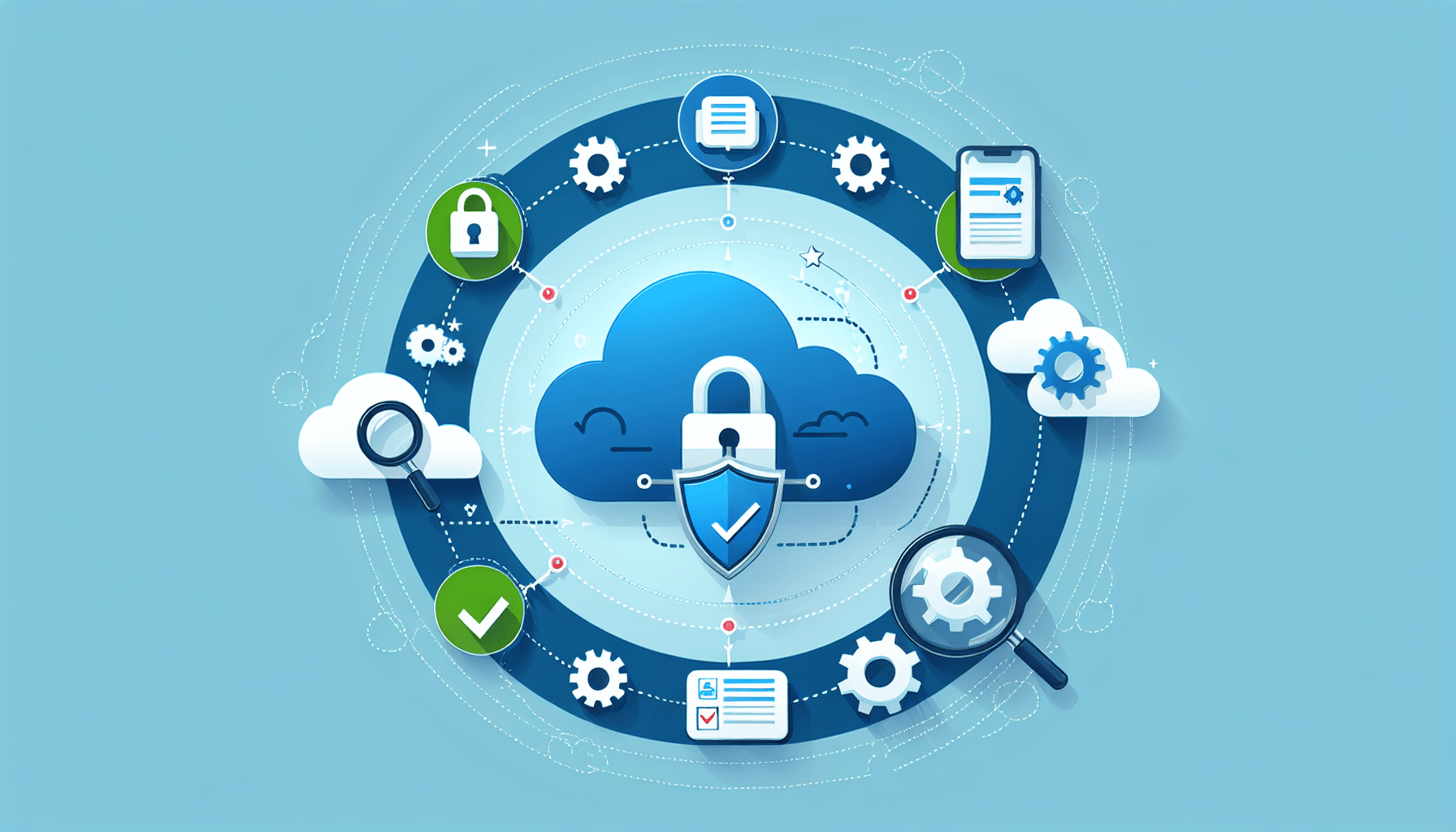In today’s digital world, cloud security has become a paramount concern for organizations of all sizes. As businesses increasingly rely on cloud services to store and access sensitive data, the need for robust security measures to protect against cyber threats has never been greater. To ensure the effectiveness of cloud security assessments, it is crucial for organizations to measure key metrics that provide insights into the strength of their security defenses. By proactively monitoring these metrics, companies can identify vulnerabilities, address potential risks, and ensure the ongoing security of their cloud environments. In this article, we will explore the key metrics that organizations should prioritize when evaluating their cloud security assessments, enabling them to make informed decisions and safeguard their critical data.
Introduction to Cloud Security Assessments
What are cloud security assessments?
Cloud security assessments are systematic evaluations of the security measures and controls implemented within cloud computing environments. These assessments aim to identify vulnerabilities and risks that could potentially compromise the confidentiality, integrity, and availability of data and resources stored and processed in the cloud.
Why are cloud security assessments important?
Cloud security assessments are crucial in ensuring the integrity and security of cloud-based systems and data. With the increasing reliance on cloud computing, organizations are faced with numerous security challenges and risks. By conducting regular assessments, businesses can proactively identify and address vulnerabilities before they can be exploited by malicious actors.
The need for measuring the effectiveness of cloud security assessments
Measuring the effectiveness of cloud security assessments is essential to ensure that the implemented security controls are providing adequate protection. It allows organizations to identify areas of improvement and allocate resources effectively to address any identified vulnerabilities. By measuring effectiveness, organizations can continuously enhance their cloud security posture and reduce the risk of potential security breaches.
Understanding the Cloud Security Assessment Process
Defining the scope of the assessment
The first step in the cloud security assessment process is defining the scope of the assessment. This involves identifying the cloud-based systems, assets, and processes that will be included in the assessment. By clearly defining the scope, organizations can ensure that all relevant components are assessed, minimizing the risk of overlooking potential vulnerabilities.
Identifying and classifying assets
Once the assessment scope is defined, the next step is to identify and classify the assets within the cloud environment. This includes identifying sensitive data, critical systems, and infrastructure components. By categorizing assets based on their criticality and sensitivity, organizations can prioritize their security efforts and allocate resources accordingly.
Assessing vulnerabilities and risks
The assessment process involves identifying vulnerabilities and assessing associated risks within the cloud environment. This may include conducting vulnerability scans, penetration testing, and threat modeling exercises. By assessing vulnerabilities and risks, organizations can better understand their security posture and prioritize remediation efforts.
Implementing security controls
Based on the vulnerabilities and risks identified, organizations should implement appropriate security controls to mitigate the identified risks. This may include implementing access controls, encryption mechanisms, intrusion detection systems, and network monitoring tools. Implementing effective security controls is crucial in protecting the cloud environment from potential threats.
Testing and validating security measures
Once the security controls are implemented, organizations should conduct rigorous testing and validation to ensure their effectiveness. This may involve conducting penetration testing, vulnerability assessments, and simulating real-world attack scenarios. By testing and validating security measures, organizations can identify any weaknesses or gaps in their defenses and take necessary actions to address them.

Key Metrics for Assessing Cloud Security Effectiveness
Compliance with industry standards and regulations
One of the key metrics for assessing cloud security effectiveness is compliance with industry standards and regulations. This involves evaluating whether the cloud environment meets the requirements set forth by relevant standards such as GDPR, HIPAA, ISO 27001, and others. Compliance with these standards ensures that organizations follow best practices in securing cloud-based systems and data.
Time taken to identify vulnerabilities
The time taken to identify vulnerabilities is another vital metric for assessing cloud security effectiveness. It measures the efficiency of vulnerability detection processes and indicates how quickly potential weaknesses within the cloud environment are identified. A shorter time to identify vulnerabilities allows organizations to respond promptly and reduce the window of opportunity for potential attacks.
Percentage of vulnerabilities mitigated
The percentage of vulnerabilities mitigated measures the effectiveness of the remediation efforts taken to address identified vulnerabilities. It indicates how well the security controls implemented within the cloud environment are able to mitigate the identified risks. A higher percentage of vulnerabilities mitigated indicates a more robust security posture.
Incident detection and response time
Incident detection and response time is a critical metric for assessing the effectiveness of incident management processes within a cloud environment. It measures the average time taken to detect and respond to security incidents, such as unauthorized access attempts or data breaches. A shorter incident detection and response time allows for quicker containment and mitigation of potential threats.
Availability and uptime percentage
The availability and uptime percentage measure the reliability and accessibility of cloud services. It indicates the percentage of time that the cloud services are available and accessible to users. A higher availability and uptime percentage reflect a more reliable and resilient cloud infrastructure.
Data breach occurrences and impact
Measuring the occurrences and impact of data breaches is crucial in assessing the overall security effectiveness of a cloud environment. It involves quantifying the number of data breaches and evaluating the size and sensitivity of the compromised data. Additionally, it considers the financial impact of the breaches and the resulting damage to customer trust and reputation.
Cost of managing security incidents
The cost of managing security incidents is an important metric for assessing the financial impact of security breaches within the cloud environment. It includes the cost of incident response and recovery, the cost of security tooling and monitoring, and the cost of security training and awareness programs. By measuring the cost of managing security incidents, organizations can better allocate resources and justify investments in cloud security.
User satisfaction and feedback
User satisfaction and feedback provide insights into the perceived security effectiveness of the cloud environment. It involves gathering feedback from users regarding their satisfaction with the security measures implemented within the cloud services. By understanding user perspectives, organizations can identify areas of improvement and enhance their overall security posture.
Number and severity of security incidents
The number and severity of security incidents are crucial metrics for assessing the overall security effectiveness of a cloud environment. It involves quantifying the number of security incidents, such as unauthorized access attempts or malware infections, and evaluating their severity. By tracking the number and severity of security incidents, organizations can identify trends and patterns and take necessary actions to mitigate future risks.
Impact on business operations
Assessing the impact of security incidents on business operations measures the disruption caused by security breaches. It includes evaluating the financial impact of security incidents, the downtime and its effect on productivity and revenue, as well as the impact on customer satisfaction and loyalty. By understanding the impact on business operations, organizations can assess the overall effectiveness of their cloud security measures.
Measuring Compliance with Industry Standards and Regulations
Assessing alignment with GDPR, HIPAA, ISO 27001, etc.
Measuring compliance with industry standards and regulations involves assessing the alignment of the cloud environment with relevant frameworks such as GDPR, HIPAA, ISO 27001, and others. It focuses on evaluating whether the necessary controls and processes are in place to meet the specific requirements of each standard or regulation.
The number of compliance gaps identified and resolved
Another metric for measuring compliance with industry standards and regulations is the number of compliance gaps identified and resolved. It indicates the effectiveness of the organization’s efforts to close any security gaps and align with the specified requirements. The lower the number of compliance gaps, the higher the level of compliance achieved.
Completeness and accuracy of compliance documentation
The completeness and accuracy of compliance documentation are crucial for assessing compliance with industry standards and regulations. It involves evaluating the documentation that demonstrates adherence to the specified requirements. The completeness and accuracy of compliance documentation reflect the organization’s commitment to maintaining a secure cloud environment.

Evaluating Vulnerability Identification and Mitigation
Time taken to identify vulnerabilities
The time taken to identify vulnerabilities is a key metric for evaluating the effectiveness of vulnerability identification processes. Organizations should strive to minimize this time to ensure prompt detection and response to potential security risks. By reducing the time to identify vulnerabilities, organizations can mitigate security risks before they are exploited.
Number of vulnerabilities discovered
The number of vulnerabilities discovered is another metric that measures the scope and depth of vulnerability identification efforts within the cloud environment. A higher number of vulnerabilities indicates a thorough assessment and may require an increased focus on vulnerability mitigation.
Severity ratings of identified vulnerabilities
Evaluating the severity ratings of identified vulnerabilities provides insights into their potential impact on the cloud environment. It categorizes vulnerabilities based on their potential to cause harm and helps prioritize remediation efforts. By addressing vulnerabilities with higher severity ratings first, organizations can mitigate the most significant risks more efficiently.
Effectiveness of vulnerability mitigation measures
Assessing the effectiveness of vulnerability mitigation measures measures how well the implemented security controls are addressing the identified vulnerabilities. It involves evaluating whether the controls are providing adequate protection against potential exploitation. By measuring the effectiveness of vulnerability mitigation measures, organizations can ensure that the cloud environment is adequately protected.
Number and frequency of recurring vulnerabilities
Tracking the number and frequency of recurring vulnerabilities provides insights into the effectiveness of vulnerability remediation efforts. It identifies vulnerabilities that reoccur after mitigation measures have been implemented and helps identify potential root causes for resolution. By addressing recurring vulnerabilities, organizations can enhance their cloud security posture and reduce the risk of repeated incidents.
Analyzing Incident Detection and Response Time
Number of security incidents detected
The number of security incidents detected is a significant metric for evaluating the effectiveness of incident detection processes within the cloud environment. It indicates the overall security posture and the ability to identify potential threats promptly. By tracking the number of security incidents detected, organizations can assess the effectiveness of their security monitoring and detection capabilities.
Average time taken to respond to incidents
The average time taken to respond to incidents measures the efficiency of incident response processes. It quantifies the time from incident detection to the initiation of response actions. A shorter average response time enables organizations to limit the potential impact of security incidents and minimize the time window for malicious activities.
Resolution time for security incidents
The resolution time for security incidents measures the efficiency of incident management and mitigation efforts. It quantifies the time taken to resolve and recover from security incidents. By reducing the resolution time, organizations can minimize the impact on business operations and restore normalcy promptly.
Effectiveness of incident response processes
Evaluating the effectiveness of incident response processes involves assessing the ability to contain and mitigate security incidents promptly. It includes evaluating the implemented incident response plans, the effectiveness of incident containment measures, and the successful restoration of affected systems and data. By measuring the effectiveness of incident response processes, organizations can continuously improve their incident management capabilities.
Assessing Cloud Service Availability and Uptime
Percentage of uptime and availability
The percentage of uptime and availability measures the reliability and accessibility of cloud services. It quantifies the percentage of time that the cloud services are available and accessible to users. A higher percentage reflects a more reliable and resilient cloud infrastructure.
Downtime incidents and their impact on business operations
Identifying and analyzing downtime incidents and their impact on business operations is vital for assessing the availability and uptime of cloud services. It involves quantifying the number of downtime incidents and evaluating the resulting disruption. By assessing the impact on business operations, organizations can prioritize strategies and investments to minimize downtime incidents.
Efficiency of disaster recovery measures
Evaluating the efficiency of disaster recovery measures measures the ability to recover cloud services and data in the event of a disaster. It involves assessing the implemented backup and recovery procedures, the frequency of backup activities, and the successful restoration of services. By measuring the efficiency of disaster recovery measures, organizations can ensure business continuity and minimize the potential impact of disruptions.
Redundancy and resilience of cloud infrastructure
Measuring the redundancy and resilience of cloud infrastructure provides insights into its ability to withstand potential failures and disruptions. It involves evaluating the redundancy mechanisms implemented, such as backup data centers or redundant network connections. By ensuring redundancy and resilience, organizations can enhance the availability and reliability of cloud services.
Evaluating Data Breach Occurrences and Impact
Number of data breaches
The number of data breaches is a critical metric for evaluating the effectiveness of data protection measures within the cloud environment. It quantifies the instances in which unauthorized access or disclosure of sensitive data occurred. By tracking the number of data breaches, organizations can identify potential weaknesses and enhance their data protection strategies.
Size and sensitivity of data compromised
Measuring the size and sensitivity of data compromised provides insights into the potential impact of data breaches. It involves evaluating the volume and nature of the compromised data, such as personally identifiable information (PII) or intellectual property. By understanding the size and sensitivity of the compromised data, organizations can assess the potential risks and take necessary actions to mitigate the impact.
Financial impact of data breaches
Evaluating the financial impact of data breaches measures the costs associated with breach remediation, regulatory penalties, legal fees, and potential customer claims. It involves quantifying the direct and indirect financial losses incurred as a result of the breach. By measuring the financial impact, organizations can assess the effectiveness of their data breach response strategies and allocate resources effectively.
Customer trust and reputation damage
Assessing the impact of data breaches on customer trust and reputation is crucial for organizations that rely on user trust. It involves evaluating the level of damage caused to the organization’s reputation and the resulting impact on customer loyalty. By understanding the customer trust and reputation damage, organizations can take necessary actions to restore confidence and maintain positive relationships with customers.
Measuring Cost of Managing Security Incidents
Cost of incident response and recovery
Measuring the cost of incident response and recovery involves assessing the financial resources allocated to address security incidents within the cloud environment. It includes expenses related to incident analysis, containment, and recovery efforts. By measuring the cost of incident response and recovery, organizations can assess the efficiency of their incident management processes and identify opportunities for cost optimization.
Cost of security tooling and monitoring
The cost of security tooling and monitoring measures the financial investment in security technologies and solutions within the cloud environment. It includes expenses related to the procurement, deployment, and maintenance of security tools, as well as ongoing monitoring activities. By measuring the cost of security tooling and monitoring, organizations can evaluate the effectiveness of their security infrastructure and optimize resource allocation.
Cost of security training and awareness programs
Evaluating the cost of security training and awareness programs measures the financial expenditure on educating employees and stakeholders regarding cloud security best practices. It includes expenses related to training sessions, workshops, and awareness campaigns. By measuring the cost of security training and awareness programs, organizations can assess the effectiveness of their efforts to enhance security awareness and knowledge.
Assessing the Impact on Business Operations
Financial impact of security incidents
Assessing the financial impact of security incidents measures the costs incurred as a result of the incidents. It includes expenses related to incident response and recovery, customer compensation, legal fees, and potential fines. By understanding the financial impact, organizations can evaluate the overall effectiveness of their security controls and establish cost-effective strategies for incident prevention and mitigation.
Downtime and its effect on productivity and revenue
Measuring the impact of downtime on productivity and revenue involves evaluating the disruption caused by security incidents. It includes quantifying the downtime duration and assessing its effect on business operations, employee productivity, and revenue generation. By understanding the impact of downtime, organizations can prioritize investments in cloud security to minimize disruptions and maximize operational efficiency.
Customer satisfaction and loyalty impact
Assessing the impact of security incidents on customer satisfaction and loyalty measures the level of customer dissatisfaction resulting from breaches or service interruptions. It includes evaluating customer feedback, survey responses, and customer retention rates. By understanding the impact on customer satisfaction and loyalty, organizations can take necessary actions to regain customer trust and maintain positive relationships.
Legal and regulatory consequences
Evaluating the legal and regulatory consequences of security incidents involves assessing potential legal liabilities and regulatory penalties resulting from non-compliance. It includes evaluating the organization’s adherence to data protection regulations and contractual obligations. By assessing the legal and regulatory consequences, organizations can ensure compliance and minimize the risk of legal disputes or reputational damage.
In conclusion, measuring the effectiveness of cloud security assessments is crucial in ensuring the integrity, availability, and confidentiality of data and resources within cloud environments. By implementing appropriate security controls and measuring key metrics, organizations can continuously enhance their cloud security posture, protect against potential threats, and maintain regulatory compliance. It is through comprehensive assessments and continuous improvement efforts that organizations can achieve a robust and secure cloud environment.



